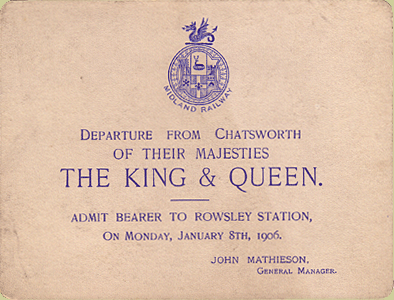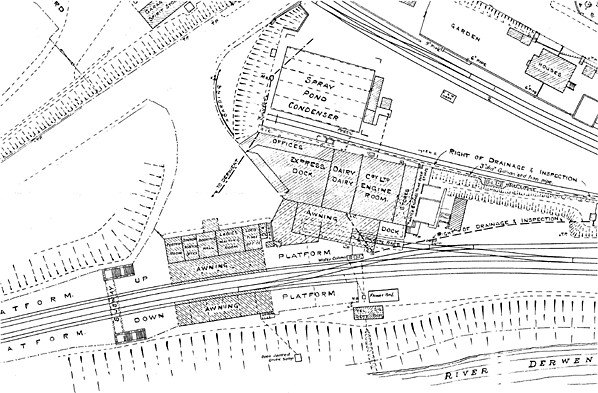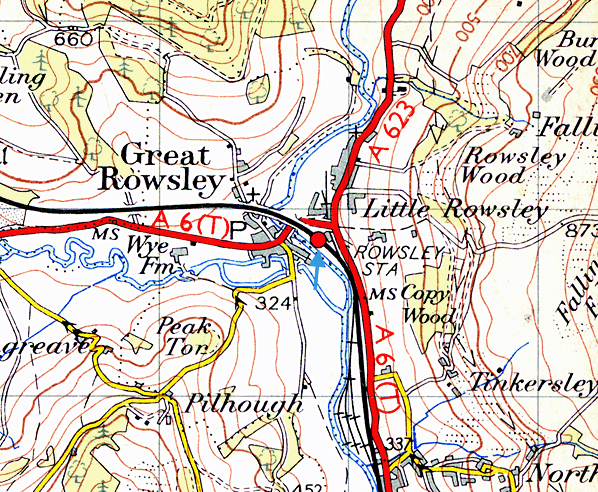Notes: Rowsley Station was situated on what became the Midland Railway’s (MR) main line between Ambergate and Manchester Central. Rowsley was a replacement station for the original terminus station of the Manchester, Buxton, Matlock & Midland Junction Railway’s (MBM&MJR) line from Ambergate to Rowsley which had opened on the 4th June 1849. Even in 1849 it had been the intention that the line would continue towards Buxton but at the time of building of the first station at Rowsley it was expected that a route via Chatsworth would be followed.
 |
It was not until after a period of stagnation resulting from the London & North Western Railway (LNWR) and the MR having taken out a joint lease of the MBM&MJR in 1852, and the LNWR wanting to prevent the MR from reaching Manchester, that any progress was made. During the 1850s two rival schemes were proposed that would have seen a line |
created to Buxton. This spurred the MR into action and they proposed a route from Rowsley to Buxton via Bakewell and Hassop. The change of route had come about because the citizens of Bakewell had lobbied the Duke of Rutland, who had in the past objected to a railway crossing his land, to change his mind as it was believed that Bakewell would decline as a town if it did not become rail connected. The Duke was persuaded and the MR submitted its plans which received an act in May 1860.
Because of the way the railway had been laid out at Rowsley, with the original station situated on an alignment suited to an extension via Chatsworth, the original station was not suitable. The new line had to deviate from the original line so a new station was built a quarter of a mile south of the original terminus.
Rowsley’s second station opened on the 1st of August 1862 when the MR’s line to Buxton had been completed as far as Hassop. The station was a grand affair as the MR knew that it would be used regularly by the Dukes of Devonshire who lived at Chatsworth. It was also realized that Royalty would be regular users of the station. The station had two platforms which were linked by a subway wich opened in 1891, the line being elevated on an embankment. The main station buildings were located on the up side of the line but no stone building were provided on the down platform. Extensive iron canopies were also provided on both platforms. Initially the station was called Rowsley but this was changed to Rowsley for Chatsworth on 1st September1867, reverting back to Rowsley on 14th June 1965. [The name Rowsley for Chatsworth did not appear on station signs until BR days – and never appeared on tickets.]
| When the station opened it was served by trains that ran between Ambergate and Hassop but on the 1st of June 1863 the line opened all the way to Buxton. Initially trains travelling south didn't go beyond Derby but were later extended to other destinations on the Midland network including London. On 1st February 1867 passenger services were introduced between |
 |
Blackwell Mill [later Millers Dale Junction] and New Mills. The route from New Mills into Manchester was the result of co-operation with the Manchester, Sheffield & Lincolnshire Railway – a section of whose line became the joint property of the Midland and MS&L in 1869. Rowsley Station was now part of a main line that stretched from London to Manchester. [Goods service commenced on 1st October 1866; passenger services were due to commence on 1st November, but this did not take place due to a landslip at Bugsworth which necessitated the construction of deviation line. Goods service recommenced on 1st February 1867.]
By the end of the 19th century Rowsley was served by local trains running between Manchester/Buxton and Derby as well as by some express services that ran between Manchester Central and London St Pancras. Stops by express trains ceased as a result of the Midland’s acceleration of services in 1904 (a consequence of competition with the L&NWR for the lucrative Manchester to London traffic). Many shorter workings also served Rowsley. By this time Rowsley had also become an important railway location in its own right. To the south of the station there were extensive sidings and a locomotive depot which opened in 1926 replacing an earlier depot close to the first station. The new depot was a brick built 4-track straight through shed with a twin gable style slate roof; facilities included a turntable, a coaling plant and a water tank.
 |
In 1923 Rowsley became part of the London Midland Scottish Railway (LMS) and although that company found itself with two routes between Manchester and London, the other being the former LNWR route, Rowsley remained as important as it had been in MR days as the line was so busy with passenger and goods services.
In January 1948 Rowsley became part of the nationalised British Railways (London Midland Region). The shed remained unaltered until closure except for the old roof was replaced in the 1950s due to its poor condition. While at times it had an allocation of a little over 60 engines, many of these could not be accommodated inside the shed itself. The shed’s allocation (and numbers of employees) was increased during WW2 due to the transfer of work into the depot.
 |
In 1960 the famous diesel Pullman which became known as ‘The Blue Pullman’ began run between Manchester Central and London St Pancras, but as it was a fast express service it did not stop at Rowsley. At the beginning of the BR era there were 6 Up and 7 Down trains stopping at Rowsley and the service got gradually worse. Indeed, the station was examined for |
closure on an individual basis in 1959. To a large extent the combination of the Station Master’s post with that at Darley Dale helped to keep it open. During this time the line was even considered for electrification. It therefore came as a surprise when all of the station between Matlock and Chinley were earmarked for closure in the 1963 Beeching Report. The Beeching report included the closure of all stations between Matlock (exclusive) and Buxton (inclusive)/Chinley (exclusive), other than Bakewell. That station was added in a legal notice that appeared in the Times of 31st October 1963.
Rowsley’s second station closed completely on the 6th March 1967. The goods yard on the site of the 1st station remained open for goods traffic until 1st July 1968. Through freight services (i.e. other than those to Rowsley and Bakewell goods depots, from the south) were withdrawn on 3rd October 1966. The expresses also ceased on 1st July 1968. The last expresses should have run on Sunday 30th June, but were cancelled due to industrial action by guards, as were the last trains on Saturday 29th June. The last express over the line was 16.20 St. Pancras to Manchester on 29th June, which left Matlock around 20 minutes late at 19.35.
The line closed completely to Peak Forest Junction. The section from there to Peak Forest itself is still open. After closure the platforms were simply filled in and buried although the main station building survived into the 1980s. Today a car park occupies part of the site.
| Peak Rail now run a steam service into Rowsley South, built on the site of the Engineer’s Sidings. They have opened a new shed on the site of the old (1926) one – albeit only about a third of the original length. The biggest problem stopping Peak Rail extending north to Bakewell is the A6 road. The road bridge was rebuilt in the summer of 1965 as the original structure had become unsound. At this time, this was the main route for passenger trains between |
 |
Manchester and London, due to the electrification of the West Coast line. It was only after the full re-opening of the WCML in April 1966 that moves were made to close the line – and this depended on the Minister of Transport’s ruling on the withdrawal of local services, which was not made until 14th September 1966. Replacing the bridge could not be deferred for what at that time were uncertain proposals. It was demolished after only 5 years and the road was raised and realigned. To extend the line north would involve either raising the trackbed or lowering the road.
Sources: Rowsley Old Station and Goods Yard by The Rowsley Association – Published by Pynot Publishing. The Monsal Trail then and now by Alistair Lofthouse – Ald print.
Other web sites: Peak Rail now providing a regular steam service between Matlock and Rowsley. David Hey's Collection - Transition from BR steam. Includes railway photographer ER Morten's photographic tour from Buxton - Derby. The Rowsley Association run by ex-railwaymen and their families from the area.
Eight and a half miles of the Matlock - Buxton line now forms the Monsal Trail starting at Coombs Road Viaduct, one mile southeast of Bakewell and finishing at the head of Chee Dale, about three miles east of Buxton. There is a diversion round the tunnels.
Further reading: Railway from Buxton to Bakewell, Matlock and Ambergate (Scenes from the Past) by JM Bentley, 1992. Railways around Buxton by JM Bentley, 1987. Rowsley : A Rural Railway Centre by Glynn Waite and Laurence Knighton, (Midland Railway Society), 2003 ISBN 0-9537486-2-6. Rowsley Railway Miscellany, edited by Glynn Waite (Rowsley Association), 2006 ISBN 978-0-9552251-1-6. Rowsley Railway Miscellany – 2, edited by Glynn Waite (Rowsley Association), 2008. ISBN 978-0-9552251-9-2. Rowsley’s Engine Sheds by Glynn Waite (Rowsley Association), 2007. The last four listed above are available from the Rowsley Association.
Additional notes and photo captions by Glynn Waite/Rowsley Association. Click here for a more detailed history of the complete closure process of the Derby - Buxton/Manchester line.
Additional source Glynn Waite. Tickets from Michael Stewart & Glynn Waite, route map drawn by Alan Young. Click here for a list of Rowsley station masters.
Click here to see a series of pictures of the A6 bridge at the north end of Rowsley station being replaced in 1965.
Click here for Rowsley 1st Locomotive depot
Click here for Rowsley 2nd Locomotive depot
Click here for Rowsley sidings
To see other stations between Manchester Central & Matlock click on the station name:Manchester Central, Chorlton-cum-Hardy, Withington & West Didsbury, Didsbury, Heaton Mersey, Cheadle Heath, Hazel Grove (Midland), Buxworth, Chinley (2nd site) STILLOPEN, Chinley (1st site), Chapel-en-le-Frith Central, Peak Forest, Cheedale Halt, Buxton (Midland), Blackwell Mill Halt, Millers Dale, Monsal Dale, Great Longstone, Hassop, Bakewell, Rowsley (1st site), Rowsley South PEAK RAIL, Darley Dale, Matlock Riverside PEAK RAIL & Matlock STILL OPEN. See also Stockport Tiviot Dale & Stockport Portwood |

old8.jpg)

second_old2.jpg)
second_old4.jpg)
second_old5.jpg)
15.jpg)
19.jpg)







12.jpg)

 Home Page
Home Page